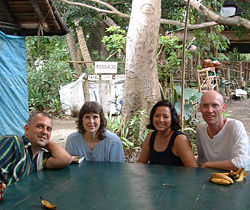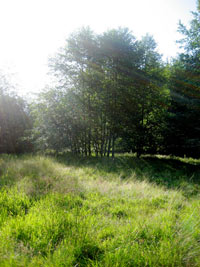Eco-Villages
The name makes them sound new and revolutionary, part of a new movement toward sustainability and community. But in reality, this is the way humans have lived for thousands of years before we took a sharp turn toward unsustainable living. Eco-villages are glimpses to the past, to how humankind used to resonate with the natural environment. They are spreading and popping up everywhere where people are found.
Here is an alphabetical list of ecovillages from the Fellowship for Intentional Community (FIC) website.
1. 5th dimensional eco-village (northern NM or southern CO, New Mexico, United States) Forming
2. Abeo (Hobart, Tasmania, Australia) Re-Forming
3. ABRA144 Ecovillage - Amazonian Bioregional Village (Presidente Figuereido, Manaus, Brazil) Forming
4. ABRACADABRA Forming
5. Abundance EcoVillage (Fairfield, Iowa, United States)
6. The Alchemical Nursery Project (Syracuse, New York, United States) Forming
7. ALDEAFELIZ (San Francisco, Cundinamarca, Colombia)
8. Alderleaf Farm and Wilderness College (Monroe, Washington, United States)
9. Aldinga Arts EcoVillage (Aldinga Beach, South Australia, Australia)
10. Aleskam (684020 Razdolny Setl, Kamchatka, Russian Federation)
11. All Are Welcome: We Invite You (Olympia, Washington, United States)
12. Amazon Highlands Eco-Cooperative (Campamento Salto Yutaje) (Puerto Ayacucho, Amazonas, Venezuela)
13. Amity Highlands Ecovillage Cohousing (Woodbridge, Connecticut, United States) Forming
14. Anarres Ecovillage (Northampton, England, United Kingdom) Forming
15. ANCIENT SOCIETY OF EOCHAID OLLATHAIR, INC. (YOUNGSTOWN, Ohio, United States) Forming
16. Andelssamfundet i Hjortshøj (DK-8530 Hjortshoj, Denmark)
17. Aquarius Nature Retreat (Vail, Arizona, United States) Re-Forming
18. Arcosanti (Cordes Lakes, Arizona, United States)
19. ASL in Veg/an Ecovillage Communities (Cottonwood area, Arizona, United States) Forming
20. Aspenwood (Santa Fe, New Mexico, United States)
Read more...
“Would it be an exaggeration to claim that the emergence of the ecovillage movement is the most significant event of the 20th century? I don’t think so.”
Sociologist Ted Trainer, University of New South Wales, Australia
“In my view, ecovillages, and the larger social movements of which they are an integral part, are the most promising and important intentional community movement in all of history."
Robert Rosenthal, Professor of Philosophy, Hanover College, USA
The “most significant event of the 20th century”? The “most important intentional community movement in all of history”? Powerful words. Let us look at what is behind them.
 When Findhorn community in northern Scotland announced the topic for their annual autumn conference in 1995 as “Ecovillages and Sustainable Communities”, they were overwhelmed with applications from all over the world, breaking all previous records. Eventually, they had to turn away about 400 people for lack of capacity in beautiful Universal Hall. Somehow they had struck a chord that resonated far and wide. The word “ecovillage”, which was barely four years old at the time, thus became part of the language of the Cultural Creatives. It was appropriate that the first major conference was at the “planetary village” of Findhorn — founded in 1962 — because it was one of the oldest and best known of the many intentional communities around the world. After October 1995, most of them, like Findhorn, began calling themselves “ecovillages”, and a new movement was born. Following the conference, a group of about 25 people, from almost as many countries, decided to formalize the sense of a major historic event by founding the Global Ecovillage Network (GEN) to link the hundreds of small projects that had sprung up around the world with a common motivation, but without having knowledge of each other. Gaia Trust, Denmark, committed on the spot to fund the network for the first five years. (1)
When Findhorn community in northern Scotland announced the topic for their annual autumn conference in 1995 as “Ecovillages and Sustainable Communities”, they were overwhelmed with applications from all over the world, breaking all previous records. Eventually, they had to turn away about 400 people for lack of capacity in beautiful Universal Hall. Somehow they had struck a chord that resonated far and wide. The word “ecovillage”, which was barely four years old at the time, thus became part of the language of the Cultural Creatives. It was appropriate that the first major conference was at the “planetary village” of Findhorn — founded in 1962 — because it was one of the oldest and best known of the many intentional communities around the world. After October 1995, most of them, like Findhorn, began calling themselves “ecovillages”, and a new movement was born. Following the conference, a group of about 25 people, from almost as many countries, decided to formalize the sense of a major historic event by founding the Global Ecovillage Network (GEN) to link the hundreds of small projects that had sprung up around the world with a common motivation, but without having knowledge of each other. Gaia Trust, Denmark, committed on the spot to fund the network for the first five years. (1)
A Sustainable Lifestyle
Thus was born a new lifestyle movement, which may prove to be far more significant than has been realized to date in government circles and the media, who have yet to discover what is happening all across the world. The ecovillage movement — although still in its early embryonic stage — is a global phenomenon responding to global causes. It is best understood as a part of the anti-globalisation movement. But while the more visible parts of the anti-globalisation movement protest the corporate-dominated global economic model through demonstrations in the streets and consumer boycotts and through single issues movements, ecovillagers have a different approach. They are quietly building small, sustainable communities with their limited resources, with personal commitment — walking their talk. They see ecovillages as models of how we must all live eventually, if the threat to our environment and social structures posed by corporate-led globalisation is to be taken seriously. It is a lifestyle possible for everybody on the planet.
Read more...




 Ecovillages
Ecovillages




 History
History


 When
When 

